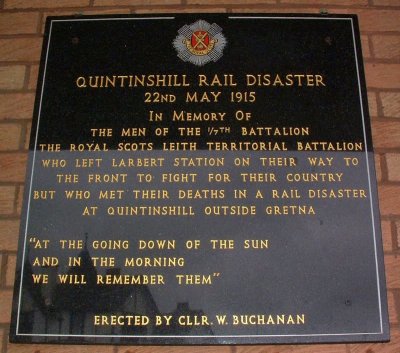Quinitnshill
I’ve changed the accident I intended to start with, which was a ‘mysterious cause’ case. I’ll start instead with the worst ever accident in the UK. In this case it’s not the causes of the accident that are mysterious, rather some details about the consequences.
First, some brief description. A typical UK mainline railway has two tracks, like a typical single carriageway A road. Down (away from London) is on the left if you imagine yourself stood in London, Up is on the right.
At Quntinshill there was a lay-by on each track so faster trains could overtake slower ones.
It is early morning Saturday, May 22nd, 1915. At this distance from London (Quininshill is just over the Scottish border north of Carlisle) the line is actually quite busy. There are overnight trains from London heading north, coal trains both empty and full concerned with supply to the Royal Navy in the far north, and a troop train heading south to embark two companies of the Royal Scots at Liverpool bound for the Dardanelles.
In among all this important traffic is a somewhat dilatory down local train. Unusually it is headed on this day by a particularly large locomotive, an express engine running in after overhaul. This train is being overtaken by an express from the south. Unfortunately at Quintinshill both the lay-bys are occupied by coal trains. So the signalman then on duty (whose relief is on the local) decides to shunt it across from the down line to the up line. His relief jumps off the local as it is reversing across, goes up to the box, and takes over duty. Meanwhile the troop train is approaching on the same (up) line. No problem, the signals are set to danger.
It is 6:27 am.
At 6:47, the relief signalman who has travelled on the train now parked on the up line
right outside the signalbox clears the signals for the up troop train. The results are catastrophic. The troop train hits the local at 70mph, and the down express runs into the wreckage seconds after. The coaches (mostly) are wooden and have gas lights, the gas cylinders rupture and are set alight.
The death toll is 227. Of 500 Royal Scots only 54 could be mustered at a roll call, the rest dead or seriously injured.
The mysteries
- Unidentified Victims. We will come across this again. There were 4 (some say 5) sets of remains that were never identified. A woman and three children. There were contemporary suggestions that they were Belgian refugees that had stowed away. That makes no sense. It would be a fairly deranged person that would wish to return from Glasgow to Belgium in 1915.
- Desertions. The fire was so fierce that about 50 of the Royal Scots were listed as ‘missing’ . Contemporary rumour has it that at least some of them, either deliberately or through shock, deserted. Officially this is denied.
- Mercy Killings. Allegedly some soldiers trapped in the wreckage were shot to prevent them from further agony because they could not be saved from the fire. Certainly some soldiers had limbs amputated to free them from the wreckage before they were burnt alive.
- The relief signalman. A couple of contemporary references suggest he might have been subject to fits. I myself think that this – if true at all - was a response to the accident rather than a cause – there were other people in the signalbox with him who would surely have noticed? But of course medical checks in 1915 would be much less rigorous than today.
- It took 4 hours before the Carlisle fire brigade (10 miles away) arrived at the scene, by which time the fire was totally out of control.
Only relatively minor mysteries in the overall scheme of things, but still chewed over by investigative authors until this day – there was a book published in 2013 called “The Quntinshill Conspiracy’.



